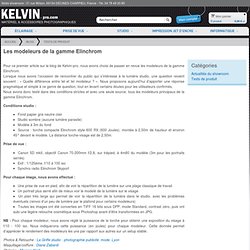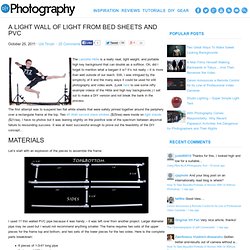

Pierre Cimburek Blog. Le blog de Kelvin-Pro.com - Test de matériel éclairage lumière, boitiers et dos numériques. Pour ce premier article sur le blog de Kelvin-pro, nous avons choisi de passer en revue les modeleurs de la gamme Elinchrom.

Lorsque nous avons l’occasion de rencontrer du public qui s’intéresse à la lumière studio, une question revient souvent : « Quelle différence entre tel et tel modeleur ? ». Nous proposons aujourd’hui d’apporter une réponse pragmatique et simple à ce genre de question, tout en levant certains doutes pour les utilisateurs confirmés. Nous avons donc testé dans des conditions strictes et avec une seule source, tous les modeleurs principaux de la gamme Elinchrom. Conditions studio : Fond papier gris neutre clair Studio sombre (aucune lumière parasite) Modèle à 3m du fond Source : torche compacte Elinchrom style 600 RX (600 Joules), montée à 2,50m de hauteur et environ 45° devant le modèle.
Prise de vue : Pour chaque image, nous avons effectué : NB : Pour chaque modeleur, nous avons réglé la puissance de la torche pour obtenir une exposition du visage à f/10 - 100 iso. Portrait Lighting Cheat Sheet Card. Setting up lighting for a portrait can be quite a complex task.

If you, like me, are using small strobes which have mo modeling light it is hard to predict what will be the outcome of each lighting array. There are however some basic lighting schemes, kind of a starting ground for new portraits. Of course, once you lay out the initial lighting you can change it, move it around and use modifiers to soften or restrict the light. Wouldn’t it be nice, though if you have a magic card that will show you what will be the final lighting of almost every lighting scheme? I think it can be pretty darn cool. So, after reading Light, Science and Magic, watching the lighting tutorials from pro photo life and getting my share of the Strobist, I decided to create the Portrait Lighting Cheat Sheet. iPad + iPhone Picture in Picture In 8 Easy Steps.
Lying in bed one night reading a Photography eMag on my iPad I was drawn to a photography competition for a Picture in Picture.

Instantly and idea shot into my head to use the iPad for a Picture in Picture photo where it appears as if the iPad screen is transparent. I decided that a shot of an apple on the kitchen table would keep the scene easy but also add a bit of reason. The photo turned out well and after sharing it on Facebook one of my friends presented me with another challenge, to also include an iPhone in the photo giving it a third level. The iPad iPhone Picture in Picture was born.
I decided to make a self-portrait using the iPhone to display my eyes and the iPad to display the majority of my face (or as much of my big head as would fit). Ingredients To recreate the photo you will need the following equipment. A Light Wall Of Light From Bed Sheets And PVC. The Lastolite Hilite is a really neat, light weight, and portable high key background that can double as a softbox.

Oh, did I forget to mention what a bargain it is? It’s not really – it is more than well outside of our reach. Still, I was intrigued by the simplicity of it and the many ways it could be used for still photography and video work. (Look here to see some nifty example videos of the Hilite and high key backgrounds.) I set out to make a DIY version and not break the bank in the process. How To Build A Gorillapod Based Cineskates-Like Dolly. A few weeks back Kickstarter’s Cineskates project funded with almost half a million from backers.

It was only a matter of time till someone came up with a budget friendly solution. Instructables user fungus amungus built a similar contraption using a Hybrid Gorillapod and $35 worth of Rollerblade wheels (for two sets of dollies). For this project you actually have to drill the Gorillapod unlike the click-based Cineskates system, but saving about a $100 may provide some incentive. [Tripod Dolly on instructables] How To Win The "I Have No Studio" Challenge. Having dealt with all kinds of spaces to shoot in, I can say that having to deal with a small space to shoot portraits is one of my worst fears.

(This is why I conquered the basement in our new house). Seeing the huge studios of folks like Zack Arias or Scott Kelby can have a paralyzing effect and send you on a the road to Im-never-gonna-make-anything-good-with-my-space trip. A few weeks ago I started talking with photographer Matthew Shalaby who is doing some amazing work with a very confined space.
Actually Matthew has been shooting for a very short time and not only dealing with the lack of a “decent” studio (shoots in a 8 feet by 10 feet room) but also the lack of a crew. So most of his work is done in a TFx (Time For Prints/CD/Other) form. Studio lighting for white backgrounds. Introduction to Studio Lighting.